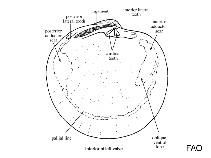Lucina pectinata (Gmelin, 1791)
Thick lucineWarning: DOMDocument::load(): SSL operation failed with code 1. OpenSSL Error messages: error:140770FC:SSL routines:SSL23_GET_SERVER_HELLO:unknown protocol in C:\Apache24\htdocs\includes\SpeciesSummary.lib.php on line 1236
Warning: DOMDocument::load(): Failed to enable crypto in C:\Apache24\htdocs\includes\SpeciesSummary.lib.php on line 1236
Warning: DOMDocument::load(https://sealifebase.nrm.se/webservice/AquaMaps/getAMap.php?genus=Lucina&species=pectinata): failed to open stream: operation failed in C:\Apache24\htdocs\includes\SpeciesSummary.lib.php on line 1236
Warning: DOMDocument::load(): I/O warning : failed to load external entity "https://sealifebase.nrm.se/webservice/AquaMaps/getAMap.php?genus=Lucina&species=pectinata" in C:\Apache24\htdocs\includes\SpeciesSummary.lib.php on line 1236
Upload your photos
Google image | No image available for this species;
drawing shows typical species in Lucinidae.
Google image | No image available for this species;
drawing shows typical species in Lucinidae.
Classification / Names Common names | Synonyms | CoL | ITIS | WoRMS
| Lucinida | Lucinidae
Environment: milieu / climate zone / depth range / distribution range पारिस्थितिकी
; खारा; गहराई सीमा 0 - 2 m (Ref. 87155). Subtropical; 27°C - 28°C (Ref. 87155); 36°N - 29°S, 98°W - 34°W
वितरण देश | ऐफ ऐ ओ क्षेत्र | Ecosystems | संयोग | भूमिका
Western Atlantic: Canada to North Carolina, Florida, Texas, West Indies, Venezuela, Suriname, Brazil (Amapa to Santa Catarina).
Length at first maturity / आकार / वज़न / Age
Maturity: Lm 3.0 range ? - ? cm
Depth range from Belize (Ref. 87155). Minimum depth based on its ecology (Ref.104470). Typically found in calm waters (Ref. 105409). Dominates confined areas of mangrove swamps. Lives deeply burrowed in reducing mud (Ref. 104215). Also in sandy-muddy sediments burrowing from 10 to 20 cm (Ref. 104470). Strictly filter-feeder (Ref. 104242), specifically a suspension feeder (Ref. 105409). In general, suspension feeding bivalves mainly depend on phytoplankton and detritus material for nutrition (Ref. 107088).
Life cycle and mating behavior परिपक्व अवधि | पुनरुत्पत्ति | मछलीऔ का अंडे देना | अंडे | Fecundity | लार्वा
Life cycle: Embryos develop into free-swimming trocophore larvae, succeeded by the bivalve veliger, resembling a miniature clam (Ref. 833).
Main reference
संदर्भ | संयोजक | सहयोगीयो
Turgeon, D.D., J.F. Quinn Jr., A.E. Bogan, E.V. Coan, F.G. Hochberg, W.G. Lyons, P.M. Mikkelsen, R.J. Neves, C.F.E. Roper, G. Rosenberg, B. Roth, A. Scheltema, F.G. Thompson, M. Vecchione and J.D. Willams. 1998. (Ref. 1667)
IUCN Red List Status (Ref. 130435)
CITES status (Ref. 108899)
Not Evaluated
CMS (Ref. 116361)
Not Evaluated
Threat to humans
Human uses
मात्स्यिकी: व्यापारिक
| FishSource |
साधन
अधिक जानकारी
इंटरनेट स्रोत
BHL | BOLD Systems | CISTI | DiscoverLife | FAO(Publication : search) | Fishipedia | GenBank (genome, nucleotide) | GloBI | Gomexsi | Google Books | Google Scholar | Google | PubMed | Tree of Life | Wikipedia (Go, खोज) | Zoological Record
Estimates based on models
Preferred temperature
(Ref. 115969): 26.5 - 28.3, mean 27.4 (based on 306 cells).
Price category
(Ref. 80766):
Unknown.



